Homemade elderberry cordial is one of my go to elderberry recipes, for making immune-boosting, refreshing drinks.
Elder trees grow all over the island of Ireland and their berries are full of natural goodness. Elder berries and flowers are used for making cordials, granitas, syrups, jellies, and sauces.
Today's recipe is for a cordial, using dried berries and honey - a perfect fruity, pick-me-up in the winter months.

Table of Contents
What is Fruit Cordial?
In Ireland and the United Kingdom, fruit cordials are concentrated syrups made from fruits, that are then combined with water or another liquid to create a drink.
Medicinal cordials are concentrated mixtures that are invigorating and stimulating, and are intended for a medicinal purpose, according to Wikipedia.
Today's elderberry cordial fits both cordial definitions.
Elderberry cordial is a wonderful way to make use of wild elderberries, if you're lucky enough to live in an area where they grow. This recipe uses dried berries so it can be made all year round.
Perfect for the winter and flu season this cordial brings antioxidant benefits, especially when paired with local honey.
Elderberries are in season between August and October and can be found in the woodlands and hedgerows of Ireland.
In the late summer and autumn or fall months, this cordial is delicious when added to sparkling water.
It can also be used as a base for cocktails or paired with a clear spirit of your choice.
Elderberry concentrate is used in the manufacture of gummies, lozenges, pills, teas, food coloring, body lotions, jams, and wine.
Dried versions of elderberry are more widely available in America, where it's difficult to find the fresh fruit.
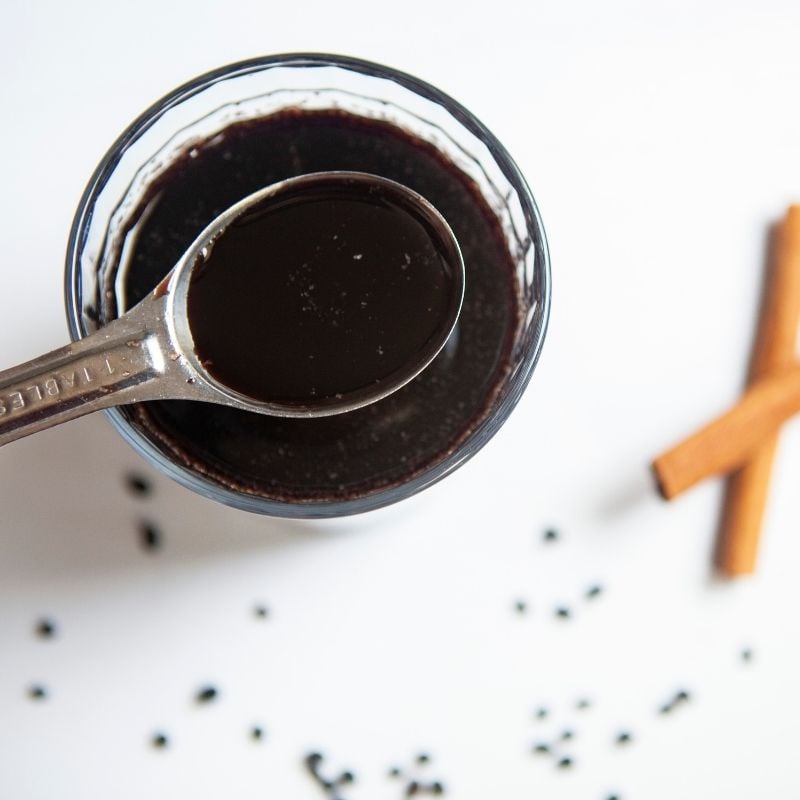
Elder Tree Facts
Elder trees are native to Europe, Africa and Asia, but they also grow in America. This tree propagates easily and can often be found on railway embankments in Ireland (not a safe place for harvesting the fruit).
A small slip of the tree can be stuck into the ground, and it often takes root.
From late spring to early summer these bushes produce beautiful white blossoms. These fragrant flowers are often used for making an elderflower champagne or cordial.
The flower heads transform into small dark berries by fall. The berries are very small and when harvesting a cluster of small branches is usually picked. A fork can be used to remove the berries, or they can be slowly picked off one by one.

Berries That Need To Be Cooked
Elderberries and flowers are best cooked, which removes any trace toxins which are found in some forms of the plant. Consuming raw elderberries can cause nausea, vomiting and diarrhea.
The most common form of the plant found in Ireland is called sambucus nigra and is considered to be non-toxic. However, because other varieties of elder are toxic, it's always best to cook these little berries.
Their flavor improves greatly with cooking, concentrating the sweetness of this fruit.
They also can be dried and stored. This recipe calls for dried, preserved elderberries rather than fresh elderberries. The dried berries can be added to scones and other bread baking recipes too.
I like using dried elderberries since it cuts out the time consuming task of stripping the fresh elderberry clusters from their stems and removing the stalks.

Are Elderberries Good For You?
Hippocrates, the most famous physician of Ancient Greece, referred to the elder tree as his 'medicine chest.' That's high praise from 400 BC.
Elderberries have been used in Irish folk medicine for centuries, where the elderberry is considered one of the most healing plants found in the rural Irish landscape.
These berries have antibacterial, anti-viral and antioxidant benefits. But be warned, they do have laxative properties too, and are used as a cure for constipation.
Elderberries offer a better nutrition profile than elder flowers. Vitamin C from the berries helps boost the immune system and cardiovascular system.
In folk medicine this cordial was used to guard against colds and flus and was even used to treat tonsillitis. At the first sign of flu symptoms a batch of elderberry cordial would be brewed.
So, to sum it all up, elderberries are good for you, and this soothing cordial is like a homemade spoonful of medicine.

What is a Cordial?
In Ireland a cordial is a non-alcoholic tonic or syrup made from fruit concentrate and is very sweet.
Fruit cordials are then mixed with water or other sparkling drinks.
A cordial is often called a squash. They come in many flavors such as lemon, orange, or blackcurrant (Ribena). They're used to make barley waters too. Squash or cordial comes in concentrate form and added to water or tonic water (seltzer) to create a refreshing drink.
And so let's take a look at how to make a homemade cordial using dried elderberries.
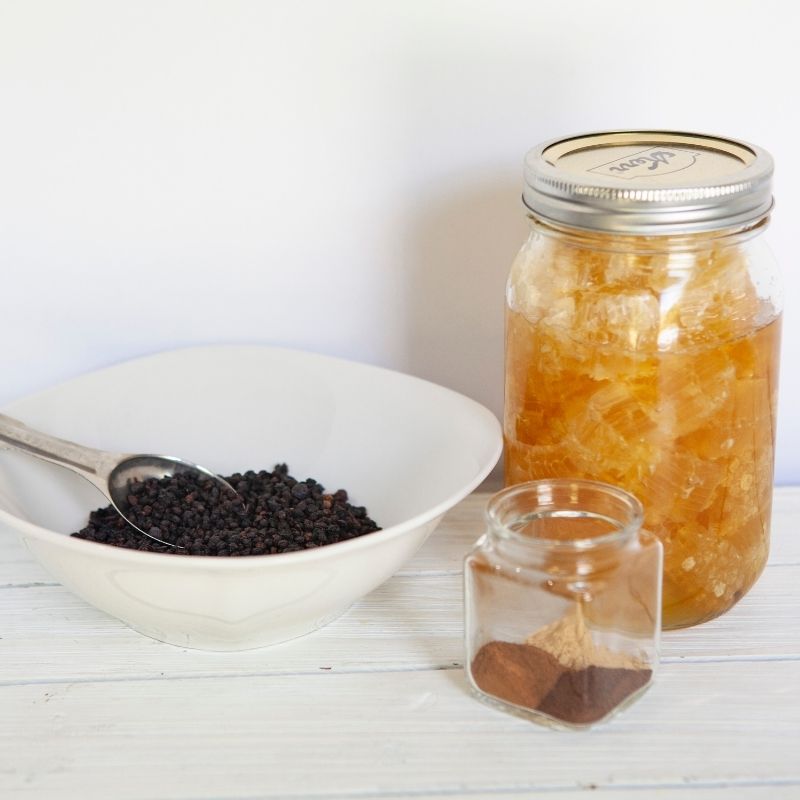
Ingredients For Cordial
Here you’ll find a quick list of what you’ll need for this recipe. Check out the printable recipe at the bottom of this post for US and Metric equivalent versions of the recipe. There you can choose the measurement system that works best for you.
- dried elderberries
- water
- honey as a sweetener. Use raw honey for extra medicinal properties.
- ground cinnamon
- ground ginger
- ground cloves
You will need a fine mesh strainer or a cheesecloth to strain these berries after they've been simmered.
Also, cinnamon sticks are a great way to stir this drink. They add lots of flavor.
I use simple spices - just cinnamon, ginger and ground cloves. Star anise is another great addition.
I don't add any alcohol to this cordial. A drop of brandy add great depth of flavor. The alcohol will simmer off as you cook the berries.
I don't use any lemon juice in this version of elderberry cordial, but feel free to squeeze a few oranges or lemons to add a little tang. Be sure to pass this juice through a muslin cloth to avoid adding any pulp to your cordial.
Lemon juice or citric acid will increase the shelf life of your elderberry cordial.
Here's how to make this beneficial syrup.
Directions
Here you’ll find step-by-step photographic instructions to help you recreate this recipe successfully. There are plenty of tips included along the way.
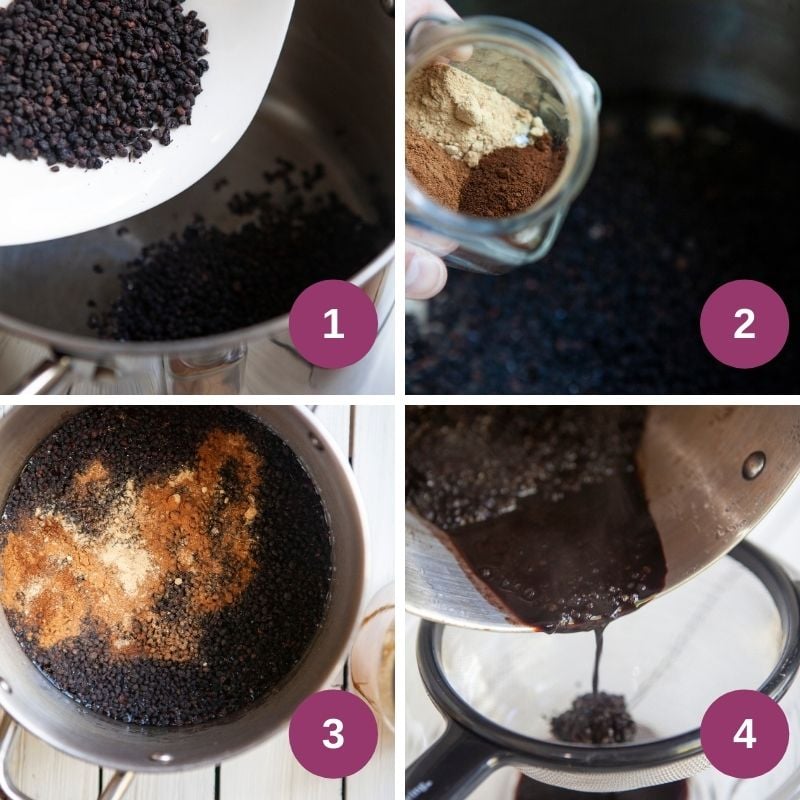
- Place the dried elderberries, and water in a large pot.
- Add the ground ginger, cinnamon and cloves to the elderberry mixture.
- Bring to a boil over high heat and then reduce to low. Simmer for 45 minutes or until the mixture has reduced in volume by half.
- Remove from the pan from the heat and allow the mixture to cool to room temperature before straining
- Once mixture has cooled, use a mesh strainer or cheesecloth to strain the berries. Pour the contents of the saucepan slowly into the colander.
- Press all the juice out of the berries using a spatula or the back of a spoon.
- Once all the juice has been squeezed out, discard the elderberries. Next, add 1 cup of honey to the mixture and stir until well combined.
- The finished cordial should be refrigerated for storage.

It really is that simple.
The resultant syrup mixed with honey is syrupy, and drips off the end of a spoon.
It's concentrated so not for drinking all at once.
A spoonful per day is the perfect choice, and it can be taken in undiluted form or mixed with sparkling seltzer or just pour into plain water.
Add it to oatmeal or yogurt to add a nutritious kick to breakfast with extra antioxidants. The choices are endless.
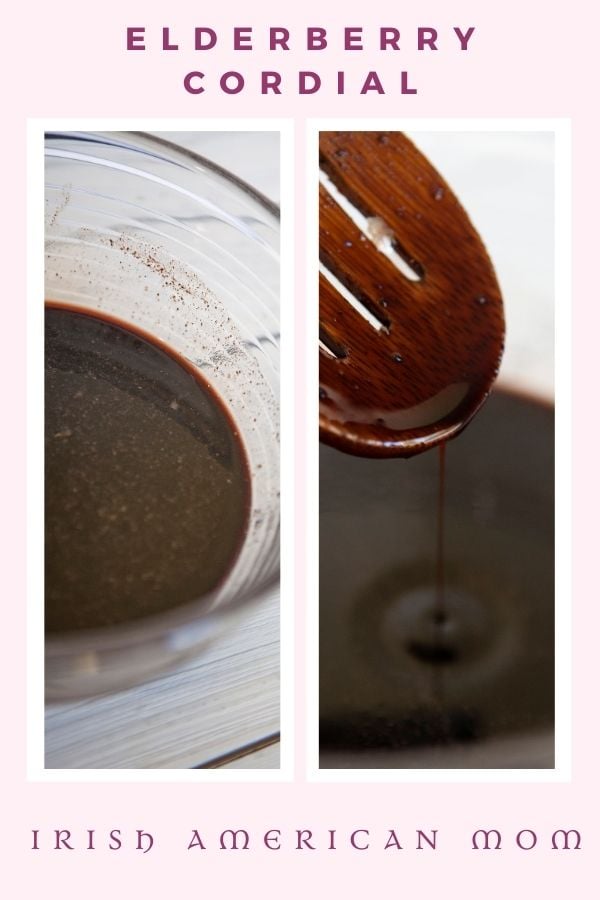
Recipe Card for Homemade Elderberry Syrup
Here's a video summarizing the steps.
If you would like to print this recipe, here it is.
Elderberry Cordial
Equipment
Ingredients
- ⅔ cup dried elderberries
- 3 cups water
- 1 cup honey raw, local honey best if available
- 1 teaspoon ground cinnamon
- 1 teaspoon ground ginger
- 1 teaspoon ground cloves
Instructions
- Place elderberries, water, ginger, cinnamon and cloves in a large pot. Bring to a boil, then reduce the heat to low and simmer for 45 minutes o until the mixture has reduced in volume by half.
- Remove from heat and allow to cool to room temperature.
- When cooled use a mesh strainer or cheesecloth to strain the berries. Use a spatula or the back of a spoon to press all the juice out. Discard the elderberries.
- Add honey to the mixture and stir until well combined. Store in an airtight bottle or container in the refrigerator.
Nutrition Information is estimated based on the ingredients and cooking instructions as described in each recipe and is intended to be used for informational purposes only. Please note that nutrition details may vary based on methods of preparation, origin and freshness of ingredients used.
How To Use Elderberry Syrup
Elderberry cordial is very concentrated and a little goes a long way.
As an immune booster or preventative children should take 1 teaspoon per day. It can be taken directly off a teaspoon or mixed in another drink or food.
Adults can take one tablespoon per day as a preventative.
When fighting a cold or flu it's quite alright to increase the frequency for taking the recommended dose. A spoonful of syrup two to three times per day will increase intake of Vitamin C and boost your immune system to help fight a cold.

Purchasing Dried Elderberries
You can purchase dried elderberries from American retailers, including Walmart.
Here are some helpful links for retailers who sell them online.
I hope you like this taste of Ireland.
Here's a Pinterest friendly image for filing this recipe on your boards.

Stay safe and well.

Slán agus beannacht,
(Goodbye and blessings)
Mairéad -Irish American Mom
Pronunciation - slawn ah-gus ban-ock-th
Mairéad - rhymes with parade
Drinks And Cocktails
- Sip Into the Season: Spiced Cranberry Hot Toddy Recipe
- Guinness Floats - A Decadent Taste of Ireland
- Smooth Satisfying Homemade Irish Cream Liqueur
- How To Make A Black Velvet Cocktail Irish Drinks Tutorial
Christmas Recipes
- Easy And Delicious Cranberry Brie Bites Recipe
- Spiced Red Cabbage
- White Chocolate Peppermint Truffles
- Cranberry White Chocolate Chip Christmas Cookies












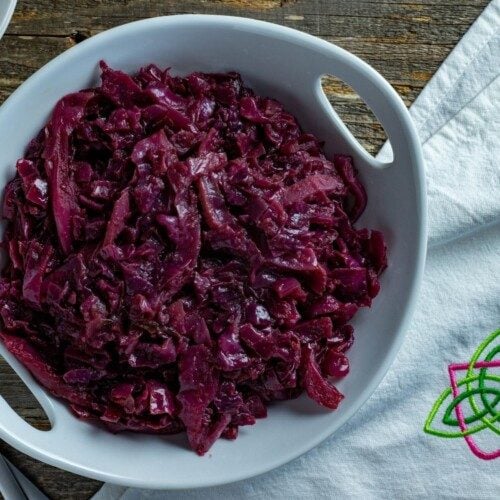






Mel
What a great recipe - looks pretty simple too. Perfect for a healthy drink.
Irish American Mom
Hi Mel - This cordial is easy to make and store and a great pick-me-up.
All the best,
Mairéad
Maggie Diamond
This recipe sounds like it could be used to make a nice cocktail! Will try it as soon as I find dried elderberries!
Irish American Mom
Hi Maggie - This cordial is perfect for cocktails. I hope you'll like it.
All the best,
Mairéad
Kitty
I will be looking for dried elderberries on my next trip to the store. Sounds very good.
Irish American Mom
Hi Kitty - Glad you like this recipe. Sometimes dried elderberries are difficult to find, but a good health food store should have them. Otherwise they're available online. Thanks so much for following my recipes and ramblings.
All the best,
Mairéad
Biana
Sounds like a delicious drink, and simple to make, too!
Irish American Mom
Hi Biana - This drink is simple and healthy. Thanks for stopping by to rate my recipe.
All the best,
Mairéad
Beth
Yum! My daughter and I love this drink! Such an easy and delicious drink to have on hand! Excited to make this again!
Irish American Mom
Hi Beth - Lovely to hear both you and your daughter love this elderberry cordial.
All the best,
Mairéad
Dannii
I haven't had elderberry cordial in years. Thanks for the reminder! I never knew it was so good for your immune system.
Irish American Mom
Hi Dannii - This is an old traditional pick-me-up from Ireland and the UK. Some of these classic recipes are still the best. Thanks for stopping by.
All the best,
Mairéad
maryanne
I absolutely love elderberries! This cordial recipes sounds so delicious!
Irish American Mom
Hi Maryanne - Lovely to hear that you too like elderberries. Thanks for taking the time to rate my recipe.
Best wishes,
Mairéad
Tania
You have me inspired to make these tonight! I always have these ingredients on hand.
Thank you!
Irish American Mom
Hi Tania - This is a great cordial to have ready to go whenever you need a refreshing and healthy beverage. Thanks for checking out my recipe.
Best wishes,
Mairéad
Hilda
Hi .
I was googling for Elderberry cordial recipe and found yours. I have 4 plants of elderberry. And didn’t know what to do with berries. I found your other recipes too. I was pleased to read details with good tricks to perfection. Thank you so much. Stay blessed.
Irish American Mom
Hi Hilda - I'm delighted you found my website and enjoyed exploring my recipes. So glad you found them helpful and I hope this elderberry cordial recipe will help you use your elderberries.
Many thanks for stopping by.
All the best,
Mairéad
Diane Lee
I just picked up some dried elderberries at my local co-op on impulse...now I know what I need to do with them! Can you use the berries after in sconces, cakes or cookies rather than discard them? I love dried currants (Scandinavian side of me for sure!) in butter cookies and tea cakes and thought that making use of the leftover berries like that would work? Thoughts? I have never worked with dried elderberries before...thank you!
Irish American Mom
Hi Diane - I have never used them for baking, but it definitely is a possibility for promoting no waste. I would use them sparingly since they would add a lot of moisture to any dough. I would recommend letting them drain in a strainer for quite a bit of time to remove as much moisture as possible. Let me know if you have any success with baking with these rehydrated berries.
All the best,
Mairéad
Rebecca
Hi there, can you confirm how long it stores for, approximately? Is it a few days, weeks or months? Thanks, Rebecca
Irish American Mom
It will keep in the fridge in airtight glass bottles for 2 to 3 weeks. If you wish to freeze it you can put it in plastic bottles, leaving space at the top to allow for expansion when the liquid turns to solid. It will keep in the freezer for up to 6 months. Dividing it into small portions by using small plastic freezable bottles is a great idea for defrosting in useable amounts. I hope this helps.
All the best,
Mairéad
ingo ERMANOVICS
how do you dry elderberry??????????????????????
Irish American Mom
Elderberries can be dried in the oven or in a food dehydrator. Here's a link with a good introduction to drying elderberries.
https://dryingallfoods.com/drying-elderberries/
All the best,
Mairéad